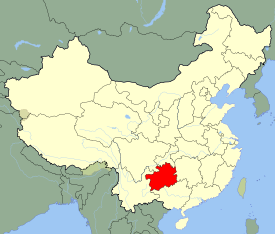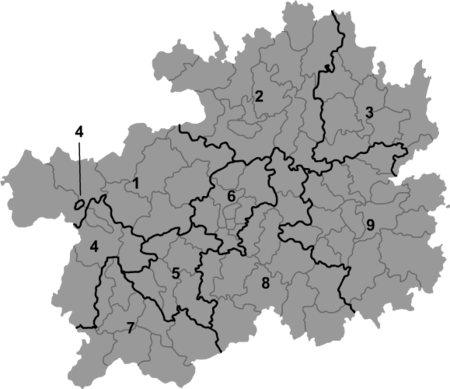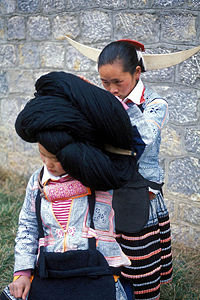- Guizhou
-
Coordinates: 26°50′N 106°50′E / 26.833°N 106.833°E
Guizhou Province Chinese : 贵州省 Guìzhōu Shěng Abbreviations: 黔 or 贵/貴 (pinyin: Qián or Guì) 
Origin of name 贵 guì - Gui Mountains
州 zhōu - zhou (prefecture)Administration type Province Capital
(and largest city)Guiyang CPC Ctte Secretary Shi Zongyuan Governor Zhao Kezhi Area 176,100 km2 (68,000 sq mi) (16th) - Latitude 24° 37' to 29° 13' N - Longitude 103° 36' to 109° 33' E Population (2010)
- Density34,746,468 (19th)
222 /km2 (570 /sq mi) (18th)GDP (2010)
- per capitaCNY 459.3 billion (US$67.8 billion) (26th)
CNY 10,258 (31st)HDI (2008) 0.690 (medium) (30th) Ethnic composition Han - 62%
Miao - 12%
Buyei - 8%
Dong - 5%
Tujia - 4%
Yi - 2%
Undistinguished - 2%
Gelao - 2%
Sui - 1%Spoken dialects Southwestern Mandarin Prefectural level 9 divisions County level 88 divisions Township level* 1539 divisions ISO 3166-2 CN-52 Official website
http://www.gzgov.gov.cn
(Simplified Chinese)Source for population and GDP data: 《中国统计年鉴—2005》 China Statistical Yearbook 2005Source for nationalities data:
ISBN 7503747382《2000年人口普查中国民族人口资料》 Tabulation on nationalities of 2000 population census of China*As at December 31, 2004
ISBN 7105054255Template ■ Discussion ■ WikiProject China  Guizhou (help·info) (simplified Chinese: 贵州; traditional Chinese: 貴州; pinyin: Guìzhōu; Wade–Giles: Kuei-chou; Postal map spelling: Kweichow) is a province of the People's Republic of China located in the southwestern part of the country. Its provincial capital city is Guiyang.
Guizhou (help·info) (simplified Chinese: 贵州; traditional Chinese: 貴州; pinyin: Guìzhōu; Wade–Giles: Kuei-chou; Postal map spelling: Kweichow) is a province of the People's Republic of China located in the southwestern part of the country. Its provincial capital city is Guiyang.Contents
History
During the Chinese Han Dynasty from about the third to the first centuries BCE, Guizhou was home to the powerful and independent Yelang polity, which covered parts of modern day Guizhou, Hunan, Sichuan and Yunnan provinces.
During the 8th and 9th centuries in the Tang Dynasty, Chinese soldiers moved into Guizhou (Kweichow) and married native women, their descendants are known as Lao-han-jen (original Chinese), in contrast to new chinese who colonized Guizhou at later times. They still speak an archaic dialect.[1] Many immigrants to Guizhou were descended from these soldiers in garrisons who married non Chinese women.[2]
It was not until the Ming Dynasty[citation needed]that it came under heavy Chinese settlement and domination during which it was made a province. This prompted mass migration from Sichuan, Hunan and its surrounding provinces into Guizhou. The Miao revolted several times against Ming during the Miao Rebellions (Ming Dynasty).
During the Qing Dynasty, Han Chinese soldiers moved into the Taijiang region of Guozhou, married Miao women, and the children were brought up as Miao.[3][4]
Many rebellions by its native Miao people occurred throughout the Qing Dynasty like the one in 1735, or (one of the longest) the uprising of 1795-1806.[5] It was said in the Qing Dynasty that every thirty years there would be minor revolts, while every sixty years there would be major rebellions. All the revolts would be violently suppressed by the government.[6]
Geography
Guizhou adjoins Sichuan Province and Chongqing Municipality to the north, Yunnan Province to the west, Guangxi Province to the south and Hunan Province to the east. Overall Guizhou is a mountainous province however it is more hilly in the west while the eastern and southern portions are relatively flat. The western part of the province forms part of the Yunnan-Guizhou Plateau.
Other cities include: Anshun, Kaili, Zunyi, Duyun, Liupanshui and Qingzhen.
Guizhou has a subtropical humid climate. There are few seasonal changes. Its annual average temperature is roughly 10 to 20 °C, with January temperatures ranging from 1 to 10°C and July temperatures ranging from 17 to 28 °C.
Like in China's other southwest provinces, rural areas of Guizhou suffered severe drought during spring 2010. One of China's poorest provinces, Guizhou is experiencing serious environmental problems, such as desertification and persistent water shortages. On 3–5 April 2010, China's Premier Wen Jiabao went on a three days inspection tour in the southwest drought-affected province of Guizhou, where he met villagers and called on agricultural scientists to develop drought-resistant technologies for the area.[7]
Politics
Main article: Politics of GuizhouThe politics of Guizhou is structured in a dual party-government system like all other governing institutions in mainland China.
The Governor of Guizhou is the highest ranking official in the People's Government of Guizhou. However, in the province's dual party-government governing system, the Governor has less power than the Guizhou Communist Party of China Provincial Committee Secretary, colloquially termed the "Guizhou CPC Party Chief".
Economy
Guizhou is a relatively poor and economically undeveloped province, but rich in natural, cultural and environmental resources. Its nominal GDP for 2009 was 389.35 billion yuan (57 billion USD). Its per capita GDP of 10,258 RMB (1,502 USD) ranks last in all of the PRC.
Its natural industry includes timber and forestry.[8] Guizhou is also the third largest producer of tobacco in China, and home to the well-known brand Guizhou Tobacco.[9] Other important industries in the province include energy (electricity generation) - a large portion of which is exported to Guangdong and other provinces[10] - and mining, especially in coal, limestone, arsenic, gypsum, and oil shale.[8] Guizhou's total output of coal was 118 million tons in 2008, a 7% growth from the previous year.[11] Guizhou's export of power to Guangdong equaled 12% of Guangdong's total power consumption. Over the next 5 years Guizhou hopes to increase this by as much as 50%.[12]
Economic and Technological Development Zones
- Guiyang Economic & Technological Development Area
- Guiyang National New & Hi-Tech Industrial Development Zone
Administrative divisions
Main article: List of administrative divisions of GuizhouGuizhou is made up of 9 prefecture-level divisions, 88 county-level divisions, and 1543 township-level divisions.
The nine prefecture-level divisions are:
Map # Name Hanzi (S) Hanyu Pinyin Administrative Seat Population (2010) 
— Prefecture-level city — 2 Zunyi 遵义市 Zūnyì Shì Honghuagang District 6,127,009 4 Liupanshui 六盘水市 Liùpánshuǐ Shì Zhongshan District 2,851,180 6 Guiyang 贵阳市 Guìyáng Shì Yunyan District 2,297,339 5 Anshun 安顺市 Ānshùn Shì Xixiu District 4,324,561 — Prefecture — 1 Bijie 毕节地区 Bìjíe Dìqū Bijie (city) 6,536,370 3 Tongren 铜仁地区 Tóngrén Dìqū Tongren (city) 3,092,365 — Autonomous prefecture — 7 Qianxinan (Buyei & Miao) 黔西南布依族苗族自治州 Qiánxī'nán Bùyīzú
Miáozú ZìzhìzhōuXingyi 2,805,857 8 Qiannan (Buyei & Miao) 黔南布依族苗族自治州 Qiánnán Bùyīzú
Miáozú ZìzhìzhōuDuyun 3,231,161 9 Qiandongnan (Miao & Dong) 黔东南苗族侗族自治州 Qiándōngnán Miáozú
Dòngzú ZìzhìzhōuKaili 3,480,626 Demographics
 The long-horn tribe, one of the small branches of Miao living in the twelve villages near Zhijing (织金) County, Guizhou Province. The wooden horns remain daily attire for most women.
The long-horn tribe, one of the small branches of Miao living in the twelve villages near Zhijing (织金) County, Guizhou Province. The wooden horns remain daily attire for most women.
Guizhou is demographically one of China's most diverse provinces. Minority groups account for more than 37% of the population and they include Miao (including Gha-Mu and A-Hmao), Yao, Yi, Qiang, Dong, Zhuang, Buyei, Bai, Tujia, Gelao and Sui. 55.5% of the province area is designated as autonomous regions for ethnic minorities. Guizhou is the province with the highest fertility rate in China, standing at 2.19. (Urban-1.31, Rural-2.42) [13]
Culture
Guizhou is the home of the Maotai Distillery, distillers of Maotai liquor, China's most famous alcoholic beverage. The Chinese name of the distillery is Zhongguo (China) Guizhou Maotai Jiuchang (Wine factory)/ China Guizhou Maotai Wine Factory (simplified: 中國貴州茅台酒厂).
Tourism
 Huangguoshu Waterfall, the largest in China.
Huangguoshu Waterfall, the largest in China.
 Drum tower in the Dong village of Zhaoxing, southern Guizhou.
Drum tower in the Dong village of Zhaoxing, southern Guizhou.
The province has many covered bridges, called Wind and Rain Bridges. These were built by the Dong minority people.
The southeastern corner of the province is known for its unique Dong minority culture. Towns such as Rongjiang, Liping, Diping and Zhaoxing are scattered amongst the hills along the border with Guangxi.
The rich population of minorities in Guizhou allow for a great many ethnic festivals throughout the lunar calendar. During the first lunar month (usually February), the early festival in Kaili (east of Guiyang) celebrates local culture with acts of bullfighting, horse racing, pipe playing, and comedy works.
Colleges and universities
Main article: List of universities and colleges in Guizhou- Guizhou University (Guiyang)
- Guizhou Normal University (Guiyang)
- Zunyi Medical College (Zunyi)
- Guiyang Medical University (Guiyang)
- Guizhou Nationalities University (Guiyang)
Media
References
- ^ (English)Scottish Geographical Society (1929). Scottish geographical magazine, Volumes 45-46. Royal Scottish Geographical Society.. p. 70. http://books.google.com/books?id=eG8cAAAAMAAJ&q=In+some+parts,+as+for+example+in+Kweichow,+the+distinction+is+made+between+the+Lao-han-jen+or+%22+Original+Chinese+%22+and+the++claim+ancestry+in+the+region+from+as+early+as+the+eighth+and+ninth+centuries+%3B+these+ancestors+were+as+a+rule+soldier-colonists+who+married+native+women,+and+their+descendants+speak+an+archaic+dialect.+The+new+Chinese,+much+more&dq=In+some+parts,+as+for+example+in+Kweichow,+the+distinction+is+made+between+the+Lao-han-jen+or+%22+Original+Chinese+%22+and+the++claim+ancestry+in+the+region+from+as+early+as+the+eighth+and+ninth+centuries+%3B+these+ancestors+were+as+a+rule+soldier-colonists+who+married+native+women,+and+their+descendants+speak+an+archaic+dialect.+The+new+Chinese,+much+more&hl=en&ei=SdPMTIrZOMaAlAez8YWbBg&sa=X&oi=book_result&ct=result&resnum=1&ved=0CCUQ6AEwAA. Retrieved 2010-06-28.
- ^ (English)Margaret Portia Mickey (1947). The Cowrie Shell Miao of Kweichow, Volume 32, Issue 1. The Museum. p. 6. http://books.google.com/books?id=vqcSAAAAIAAJ&q=Among+them+were+forced+or+voluntary+immigrants+who+came+as+families+or+clans,+garrison+soldiers+without+families+who+married+women+from+non-Chinese+groups,+and+in+more+recent+years+farmers,+business+and+professional+men,+and+officials.&dq=Among+them+were+forced+or+voluntary+immigrants+who+came+as+families+or+clans,+garrison+soldiers+without+families+who+married+women+from+non-Chinese+groups,+and+in+more+recent+years+farmers,+business+and+professional+men,+and+officials.&hl=en&ei=r9LMTLz_AsTflgftkNzjCA&sa=X&oi=book_result&ct=result&resnum=2&ved=0CCkQ6AEwAQ. Retrieved 2010-06-28.
- ^ (English) Contributions to Southeast Asian ethnography, Issue 7. Board of Editors, Contributions to Southeast Asian Ethnography. 1988. p. 99. http://books.google.com/books?id=5wOBAAAAMAAJ&q=Despite+such+conflict,+Jin+Dan+informed+me+that,+in+the+past,+some+Miao+women+in+the+Taijiang+area+married+Han+soldiers,+though+the+children+were+raised+as+Miao.+Memories+also+exist+of+Nationalist+troops,+in+the+decades+before+1949&dq=Despite+such+conflict,+Jin+Dan+informed+me+that,+in+the+past,+some+Miao+women+in+the+Taijiang+area+married+Han+soldiers,+though+the+children+were+raised+as+Miao.+Memories+also+exist+of+Nationalist+troops,+in+the+decades+before+1949&hl=en&ei=BNLMTIfrLIK0lQfZkuT8CA&sa=X&oi=book_result&ct=result&resnum=1&ved=0CCUQ6AEwAA. Retrieved 2010-06-28.
- ^ (English)Dan Jin, Xueliang Ma, Mark Bender (2006). Butterfly mother: Miao (Hmong) creation epics from Guizhou, China. Hackett Publishing. p. xvii. ISBN 0872208494. http://books.google.com/books?id=HLERRaLvOXEC&pg=PR17&dq=taijiang+miao+rebellion&hl=en&ei=ruDMTKrdIsH_lgeH1uiYBg&sa=X&oi=book_result&ct=result&resnum=1&ved=0CCcQ6AEwAA#v=onepage&q=taijiang%20miao%20rebellion&f=false. Retrieved 2010-06-28.
- ^ Elleman, Bruce A. (2001). "The Miao Revolt (1795–1806)". Modern Chinese Warfare, 1795-1989. London: Routledge. pp. 7–8. ISBN 978-0415214742.
- ^ Robert . Jenks (1994). Insurgency and Social Disorder in Guizhou: The "Miao" Rebellion, 1854-1873. Honolulu: University of Hawaii Press. ISBN 0824815890.
- ^ (English)"China's premier concerned about drought in SW China". Xinhua. 2010-04-05. http://news.xinhuanet.com/english2010/china/2010-04/05/c_13238009.htm. Retrieved 2008-09-17.
- ^ a b (English)"Market Profiles on Chinese Cities and Provinces : Guizhou Province". Hong Kong Trade Development Council (HKTD)/Guizhou Statistical Yearbook 2008. January 2009. http://info.hktdc.com/mktprof/china/guizhou.htm. Retrieved 2010-11-27.
- ^ http://thechinaperspective.com/topics/province/guizhou-province/
- ^ http://thechinaperspective.com/topics/province/guizhou-province/
- ^ (English)"Coal output in SW China province tops 100 mln tons". People's Daily Online. 2005-12-24. http://english.people.com.cn/200512/24/eng20051224_230502.html. Retrieved 2008-07-06.
- ^ The China Perspective | Guizhou Economic Facts and Data
- ^ (English)Heather Kathleen Mary Terrell (May 2005). "Fertility in China in 2000 : A County Level Analysis (thesis, 140 p.)". Texas A & M University. http://repository.tamu.edu/bitstream/handle/1969.1/3892/etd-tamu-2005A-SOCI-Terrell.pdf?sequence=1. Retrieved 2010-11-27.
External links
- (Chinese (PRC))Guizhou government website
- (English)Guiyang Government website
- (English)Arts and culture of southwest China
- (English)Guizhou Sister Rice Festival
- (English) Guizhou travel guide from Wikitravel

Sichuan Chongqing 
Yunnan 
Hunan  Guizhou
Guizhou 

Guangxi Provincial level divisions of the People's Republic of China Provinces 
Autonomous regions Municipalities Special Administrative Regions Territorial disputes Paracel, Spratly, Zhongsha Islands (see Paracels, Spratlys, & Zhongsha Iss. Authority) • Pratas Islands • Senkaku Islands • South Tibet • Taiwan, Kinmen & Matsu (see Legal status of Taiwan)
Guizhou Province county-level divisions Guiyang: Wudang District · Nanming District · Yunyan District · Huaxi District · Baiyun District · Xiaohe District · Qingzhen City · Kaiyang County · Xiuwen County · Xifeng County
Liupanshui: Zhongshan District · Pan County · Shuicheng County · Liuzhi Special District
Zunyi: Honghuagang District · Huichuan District · Chishui City · Renhuai City · Zunyi County · Tongzi County · Suiyang County · Zheng'an County · Fenggang County · Meitan County · Yuqing County · Xishui County · Daozhen Autonomous County · Wuchuan Autonomous County
Anshun: Xixiu District · Pingba County · Puding County · Guanling Autonomous County · Zhenning Autonomous County · Ziyun Autonomous County
Bijie: Bijie City · Dafang County · Qianxi County · Jinsha County · Zhijin County · Nayong County · Hezhang County · Weining Autonomous County
Tongren: Tongren City · Jiangkou County · Shiqian County · Sinan County · Dejiang County · Yuping Dong Autonomous County · Yinjiang Autonomous County · Songtao Autonomous County · Yanhe Autonomous County · Wanshan Special District
Qiandongnan: Kaili City · Huangping County · Shibing County · Sansui County · Zhenyuan County · Cengong County · Tianzhu County · Jinping County · Jianhe County · Taijiang County · Liping County · Rongjiang County · Congjiang County · Leishan County · Majiang County · Danzhai County
Qiannan: Duyun City · Fuquan City · Libo County · Guiding County · Weng'an County · Dushan County · Pingtang County · Luodian County · Changshun County · Longli County · Huishui County · Sandu Autonomous County
Qianxinan: Xingyi City · Xingren County · Pu'an County · Qinglong County · Zhenfeng County · Wangmo County · Ceheng County · Anlong CountyGuizhou topics General Geography Education Culture Visitor attractions
Wikimedia Foundation. 2010.



